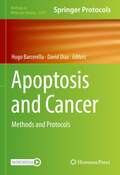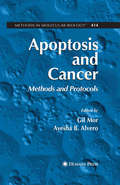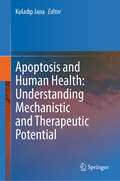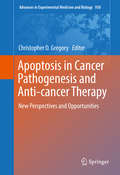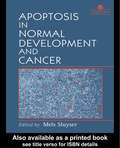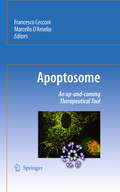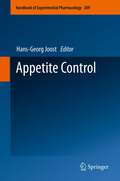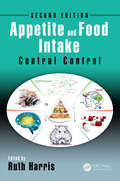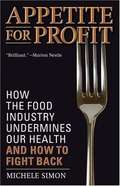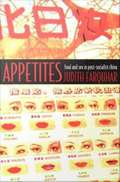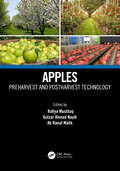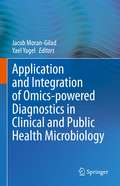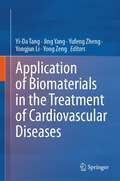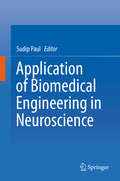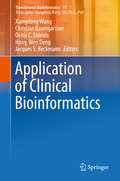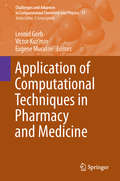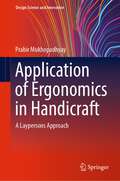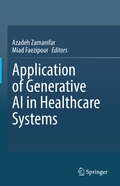- Table View
- List View
Apoptosis and Cancer: Methods and Protocols (Methods in Molecular Biology #2543)
by David Diaz Hugo BarcenillaThis volume discusses methods used in the fields of molecular and cellular biology for detecting and studying cell death, especially in cancer and cancer therapy. Chapters in this book cover topics such as non-destructive, real-time Annexin V apoptosis assay; assessment of the immune response to tumor cell apoptosis and efferocytosis; mass cytometry assessment of cell phenotypes and signaling states in human whole blood; cell cycle analysis of ER stress and autophagy; and simultaneous detection of inflammasome activation and membrane damage during pyroptosis. Written in the highly successful Methods in Molecular Biology series format, chapters include introductions to their respective topics, lists of the necessary materials and reagents, step-by-step, readily reproducible laboratory protocols, and tips on troubleshooting and avoiding known pitfalls.Cutting-edge and practical, Apoptosis and Cancer: Methods and Protocols is a valuable resource and practical guide for both novice and expert researchers looking into the “meaning of death.”
Apoptosis and Cancer: Methods and Protocols (Methods in Molecular Biology #414)
by Ayesha Alvero Gil MorThe aim of Apoptosis and Cancer is to describe the performance of contemporary techniques for studying the biology of apoptosis and its role in cancer. The protocols described will aid both the academic laboratory interested in further characterizing the mechanisms of apoptosis, as well as the industry laboratory, aimed at identifying new target molecules or screening for new compounds with potential clinical use.
Apoptosis and Human Health: Understanding Mechanistic and Therapeutic Potential
by Kuladip JanaThis book comprehensively reviews the recent advancements in apoptosis research and evaluates its therapeutic targets and strategies in controlling various human diseases. The initial chapter presents the molecular components that regulate apoptosis and its importance for pathogenic processes. The subsequent chapters discuss the molecular mechanisms and signaling pathways involved in apoptosis induction and inhibition. The book also examines the role of mitochondria-driven apoptosis and therapeutic strategies for targeting mitochondria-mediated cell death. Further, the book discusses the role of apoptosis in different diseases, including neurodegeneration, cancer, diabetes, cardiovascular diseases, parasitic infections, autoimmune diseases, reproductive disorders, and infertility. Towards the end, the book outlines the recent advances in the field of apoptosis-based therapies and explores some highlights of a very active field of drug development. This book is useful for the researchers involved in designing and developing new drugs and drug targets for the treatment of different human diseases.
Apoptosis in Cancer Pathogenesis and Anti-cancer Therapy: New Perspectives and Opportunities (Advances in Experimental Medicine and Biology #930)
by Christopher D. GregoryThis book discusses properties of apoptosis and other cell death modalities in cancer pathogenesis and treatment. Its nine chapters discuss modulation of anti-tumor inflammatory and immune responses, effects on the tumor microenvironment, to strategies for improving pro-apoptotic therapies, mechanisms and implications for disease pathogenesis, axl and mer receptor tyrosine kinases, immunogenic apoptotic cell death and anti-cancer immunity and cancer cell death-inducing radiotherapy. This book places the onco-biology of apoptosis in clear and objective perspective through an expertly synthesized series of reviews. Apoptosis in Cancer Pathogenesis and Anti-cancer Therapy is a deft and thorough exploration of cutting-edge research in apoptosis and anti-cancer mechanisms from basic biology to oncology. It highlights a rapidly growing field within cancer research and is essential reading for oncologists, biochemists and advanced graduate students alike.
Apoptosis in Normal Development and Cancer
by Mels SluyserIn apoptosis in the mammalian system, cells have a finite life - they develop, are used and then die. Cancer cells escape this programmed routine but, from an understanding of apoptosis, they can be programmed to die. This book addresses the
Apoptosome: An up-and-coming therapeutical tool
by Marcello D'Amelio Francesco Cecconi"Apoptosome" is the first book that presents a concise synthesis of recent developments in the understanding of how the activation of the cell death cascade is handled by a cytosolic signalling platform known as the apoptosome. The book also discusses how insights into the regulation of apoptosome may be exploited for designing new drugs aimed at interfere with a plethora of pathogenetic processes involved in human diseases. The authors emphasize novel translational approaches that are rapidly moving from the laboratory bench top to the patient's bedside for the future treatment of diseases associated with apoptosis. This book will be a valuable resource for researchers investigating the role of apoptosome-dependent cell death in cancer and other diseases, for researchers investigating the molecular mechanism of chemotherapeutic agents and drug-resistance and for physicians using chemotherapeutic agents. Additionally, this book will be an important educational source for PhD students and MD students specializing in molecular and cell biology, and to anybody interested in science, medicine, as well as in recent developments of the ideas and concepts of the molecular biology of programmed cell death.
Apotheke der Zukunft: Innovation – Digitalisierung – Hybride Versorgung (FOM-Edition)
by David MatusiewiczDie Apotheke als Umschlagsplatz für Arzneimittel hat ausgedient. Internetapotheken, zunehmend digitalisierte Prozesse in der allgemeinen Gesundheitsversorgung (Stichwort E-Rezept), künftig vielleicht sogar personalisierte Medikamente aus dem 3D-Drucker, sind Entwicklungen, auf die das stationäre Apothekengeschäft reagieren muss, um wettbewerbsfähig bleiben zu können.Dieses Buch erläutert die unterschiedlichen Faktoren des Strukturwandels auf dem Apothekenmarkt, lotet die Chancen der Digitalisierung aus, stellt neue mögliche Apothekenmodelle vor, zeigt ausgewählte Start-up-Beispiele, gibt noch länger aktiven Apothekern und Apothekerinnen Tipps für eine Anpassung/Transformation an die zukünftigen Entwicklungen. Es werden ausbaufähige Chancen an den Schnittstellen Apotheke und ambulante Versorgung bzw. Apotheke und nachstationäre Versorgung skizziert, die Platz für neue zukunftsfähige Geschäftmodelle lassen.
Appearance, Disability and the Law (Cambridge Bioethics and Law)
by Hannah SaundersPeople with disfigurements often face prejudice, exclusion and discrimination in employment and across other life contexts. Law's response to this evidence is flawed both by its own limited and illogical scope and its failure to understand the perspectives of those people who may need to use it. Drawing on interviews with both people with lived experience of disfigurement and employers, the book sketches out different approaches to the complex social problem of discrimination against people with visible differences. It also asks whether, in our changing social context, law should widen its protection beyond disfigurement. Would a protected characteristic of appearance offer viable legal rights to the many millions of us who do not have a disfigurement but who are prone to a few spots, whose ears stick out more than we would like, or who are carrying an extra stone in weight?
Appetite Control (Handbook of Experimental Pharmacology #209)
by Hans-Georg JoostThe volume 'Appetite Control' provides a comprehensive description of the mechanisms controlling food intake, and thereby energy balance, in the mammalian organism. During the last decade, research in this area has produced a remarkable wealth of information and has characterized the function of numerous peptides, transmitters, and receptors in appetite control. Dysfunction of these circuits leads to obesity, a growing health concern. However, the plethora of mechanistic information is in marked contrasts to an almost complete lack of anti-obesity drugs that meet the safety standards required for the chronic therapy of morbid obesity. Consequently, ongoing research aims to identify additional targets and agents for a pharmacological intervention. Thus, the mechanisms of appetite control as well as all agents interfering with its control are of considerable practical interest. The authors of the volume are distinguished scientists who are leading experts in the field, and who have contributed important, original data to our understanding of the mechanisms of appetite control. They have quite different scientific backgrounds and, together, they represent all relevant disciplines. Thereby, the topics are presented from different points of view, not exclusively from that of pharmacology and neuroendocrinology. Thus, the volume addresses all scientists who are interested in the field of obesity research and the pathophysiology of appetite control.
Appetite and Food Intake: Central Control, Second Edition
by Ruth HarrisNearly half of the world’s adult population is either clinically obese or overweight. Excess weight increases risk for multiple other chronic diseases and represents a major global health issue. Weight gain results from an imbalance between energy intake and expenditure, which can only be corrected if the physiologic and neuroendocrine systems that have the potential to control energy balance are identified. The first edition of this book reviewed knowledge on the intake of micro- and macronutrients, food choice, and opposing views on whether or not there are mechanisms that control food intake. Appetite and Food Intake: Central Control, Second Edition contains all new chapters and serves as a companion to the first by reviewing current knowledge on neuroendocrine mechanisms that influence food intake and glucose metabolism, including environmental influences on their development, with an emphasis on recent progress in understanding forebrain and hindbrain control of ingestive behavior.In addition, there is a discussion on the benefits derived from novel models for exploring ingestive behavior and the progress that has been achieved due to new technologies. Although major progress is being made in understanding the complex interplay between different control systems, the limits of our knowledge are acknowledged in chapters that review the efficacy of current weight control drugs and the relative importance of fat free mass and body fat in driving food intake.
Appetite and Its Discontents: Science, Medicine, and the Urge to Eat, 1750-1950
by Elizabeth A. WilliamsWhy do we eat? Is it instinct? Despite the necessity of food, anxieties about what and how to eat are widespread and persistent. In Appetite and Its Discontents, Elizabeth A. Williams explores contemporary worries about eating through the lens of science and medicine to show us how appetite—once a matter of personal inclination—became an object of science. Williams charts the history of inquiry into appetite between 1750 and 1950, as scientific and medical concepts of appetite shifted alongside developments in physiology, natural history, psychology, and ethology. She shows how, in the eighteenth century, trust in appetite was undermined when researchers who investigated ingestion and digestion began claiming that science alone could say which ways of eating were healthy and which were not. She goes on to trace nineteenth- and twentieth-century conflicts over the nature of appetite between mechanists and vitalists, experimentalists and bedside physicians, and localists and holists, illuminating struggles that have never been resolved. By exploring the core disciplines in investigations in appetite and eating, Williams reframes the way we think about food, nutrition, and the nature of health itself..
Appetite and Its Discontents: Science, Medicine, and the Urge to Eat, 1750-1950
by Elizabeth A. WilliamsWhy do we eat? Is it instinct? Despite the necessity of food, anxieties about what and how to eat are widespread and persistent. In Appetite and Its Discontents, Elizabeth A. Williams explores contemporary worries about eating through the lens of science and medicine to show us how appetite—once a matter of personal inclination—became an object of science. Williams charts the history of inquiry into appetite between 1750 and 1950, as scientific and medical concepts of appetite shifted alongside developments in physiology, natural history, psychology, and ethology. She shows how, in the eighteenth century, trust in appetite was undermined when researchers who investigated ingestion and digestion began claiming that science alone could say which ways of eating were healthy and which were not. She goes on to trace nineteenth- and twentieth-century conflicts over the nature of appetite between mechanists and vitalists, experimentalists and bedside physicians, and localists and holists, illuminating struggles that have never been resolved. By exploring the core disciplines in investigations in appetite and eating, Williams reframes the way we think about food, nutrition, and the nature of health itself..
Appetite and Its Discontents: Science, Medicine, and the Urge to Eat, 1750-1950
by Elizabeth A. WilliamsWhy do we eat? Is it instinct? Despite the necessity of food, anxieties about what and how to eat are widespread and persistent. In Appetite and Its Discontents, Elizabeth A. Williams explores contemporary worries about eating through the lens of science and medicine to show us how appetite—once a matter of personal inclination—became an object of science. Williams charts the history of inquiry into appetite between 1750 and 1950, as scientific and medical concepts of appetite shifted alongside developments in physiology, natural history, psychology, and ethology. She shows how, in the eighteenth century, trust in appetite was undermined when researchers who investigated ingestion and digestion began claiming that science alone could say which ways of eating were healthy and which were not. She goes on to trace nineteenth- and twentieth-century conflicts over the nature of appetite between mechanists and vitalists, experimentalists and bedside physicians, and localists and holists, illuminating struggles that have never been resolved. By exploring the core disciplines in investigations in appetite and eating, Williams reframes the way we think about food, nutrition, and the nature of health itself..
Appetite for Profit: How the Food Industry Undermines Our Health and How to Fight Back
by Michele SimonThe United States is currently embroiled in a national debate over the growing public health crisis caused by poor diet. People are starting to ask who is to blame and how can we fix the problem, especially among children. Major food companies are responding with a massive public relations campaign. These companies, including McDonald's, Coca-Cola, Kraft, and General Mills, are increasingly on the defensive. In response, they pretend to sell healthier food and otherwise position themselves" as part of the solution. Yet they continue to lobby against commonsense nutrition policies. Appetite for Profit exposes this hypocrisy and explains how to fight back by offering reliable resources. Readers will learn how to spot the PR and how to organize to improve food in schools and elsewhere. For the first time, author Michele Simon explains why we cannot trust food corporations to "do the right thing. " She describes the local battles of going up against the powerful food lobbies and offers a comprehensive guide to the public relations, front groups, and lobbying tactics that food companies employ to trick the American public. Simon also provides an entertaining glossary that explains corporate rhetoric, including phrases like "better-for-you foods" and "frivolous lawsuit. "
Appetites and Identities: An Introduction to the Social Anthropology of Western Europe
by Sara DelamontAppetites and Identities is a clear, inviting and fascinating introduction to the social anthropology of western Europe. It covers food, migration, politics, urban and country life, magic, religion, sex and language in an accessible and straightforward fashion, introducing the student to aspects of the anthropology of contemporary European culture from mussel farmers in the Netherlands to Basque chambermaids in Lourdes, and from unhappy bachelors in western Ireland to unwitchers in Portugal.Avoiding the technical language of many anthropological textbooks, Appetites and Identities sets out the anthropological literature on the rich diversity of dialects, cultures and everyday lives of western European people, offering fascinating insights on how each region and community differs from its counterparts despite the notion of an integrated Europe. The book will stimulate curiosity about social anthropological investigation, and about life in Europe today.
Appetites: Food and Sex in Postsocialist China
by Judith FarquharJudith Farquhar's innovative study of medicine and popular culture in modern China reveals the thoroughly political and historical character of pleasure. Ranging over a variety of cultural terrains--fiction, medical texts, film and television, journalism, and observations of clinics and urban daily life in Beijing--Appetites challenges the assumption that the mundane enjoyments of bodily life are natural and unvarying. Farquhar analyzes modern Chinese reflections on embodied existence to show how contemporary appetites are grounded in history. From eating well in improving economic times to memories of the late 1950s famine, from the flavors of traditional Chinese medicine to modernity's private sexual passions, this book argues that embodiment in all its forms must be invented and sustained in public reflections about personal and national life. As much at home in science studies and social theory as in the details of life in Beijing, this account uses anthropology, cultural studies, and literary criticism to read contemporary Chinese life in a materialist and reflexive mode. For both Maoist and market reform periods, this is a story of high culture in appetites, desire in collective life, and politics in the body and its dispositions.
Apple Cider Vinegar for Health and Beauty: Recipes for Weight Loss, Clear Skin, Superior Health, and Much More?the Natural Way
by Simone McgrathApple Cider Vinegar is an amazing substance that has many health benefits—it helps with weight loss, allergies, skin and health issues, and much more. It is recommended in many health programs and diets. It can be overwhelming to figure out all of the great uses of this magical vinegar, but this comprehensive handbook can help. With detailed information on everything to do with apple cider vinegar—the benefits, uses, recipes, and insightful facts—this guide will teach you all about using it to: -Lose lose weight -As a medicinal tool -Treat common ailments -For hair, skin, legs, and oral health -Cooking soups, salads, main meals, healthy drinks, and desserts More and more people are learning about the wealth of benefits that apple cider vinegar brings, and this handbook will explain all of them.
Apples: Preharvest and Postharvest Technology
by Gulzar Ahmad Nayik Rafiya Mushtaq Ab Raouf MalikDue to polymorphism, apples have extraordinary diversity. Depending on variety, apple fruits can differ in color, shade or size; apples even can be oval or pear-shaped. There are more than 10,000 varieties of apple, which vary in taste, shape, juiciness, texture, color, firmness and other qualities. For these reasons, apples have been diversely studied, and many improvements have been made such as the introduction of high density cropping; rootstock breeding; or varietal development. Therefore it is important to understand and document the production methods adopted and implemented in recent times for harvesting maximum benefits of the crop. Apples: Preharvest and Postharvest Technology documents production practices along with detailed illustration on varieties, rootstocks, important cultural practices and post-harvest management. This book will serve as a complete guide for apple production from farm to fork and will help students, scholars, researchers and scientists working in this domain. The book will also help growers all over the world to understand best practices for apple production, to harvest maximum yields, and in turn, to increase their returns.
Application and Integration of Omics-powered Diagnostics in Clinical and Public Health Microbiology
by Jacob Moran-Gilad Yael YagelVarious “omics” methods have recently revolutionized molecular diagnostics. Next-generation sequencing (NGS) makes it possible to sequence a human genome in just one day. Whole genome sequencing (WGS) greatly improves the ability to investigate the outbreaks of numerous pathogens. Metagenomics helps to analyze the microbiome, which aids greatly in identifying the pathogenesis of infectious diseases. Proteomic-based methods, namely matrix-assisted laser desorption-ionization time of flight mass spectrometry (MALDI-TOF-MS), have a promising role in identifying myctobacteria and fungi, and predicting antimicrobial resistance. While there are numerous scientific publications on “omics” applications for microbiology, there are relatively few books that review this topic from a clinical diagnostics perspective. This book looks at this field from a holistic viewpoint, instead of limiting by type of “omics” technology, in order to cover the body of knowledge needed for practitioners and academics interested in clinical and public health microbiology. Additionally, it addresses the management, economical, regulatory and operational aspects of integrating these technologies into routine diagnostics.
Application of Biomaterials in the Treatment of Cardiovascular Diseases
by Yong Zeng Yufeng Zheng Jing Yang Yi-Da Tang Yongjun LiThis book summarizes the recent advancements for biomaterials in the field of cardiovascular disease, including drug delivery system (gene, protein, drug), implant interventional instrument (heart valve, heart blocker, stent, artificial blood vessel, patch, artificial heart, cardiac pacemaker, etc.) have been innovated and applied to the clinical uses to treatment of cardiovascular disease. Through the summary of this book, readers will have comprehensive and advanced understanding of the application of biomaterials in the field of cardiovascular disease.
Application of Biomedical Engineering in Neuroscience
by Sudip PaulThis book focuses on interdisciplinary research in the field of biomedical engineering and neuroscience. Biomedical engineering is a vast field, ranging from bioengineering to brain-computer interfaces. The book explores the system-level function and dysfunction of the nervous system from scientific and engineering perspectives. The initial sections introduce readers to the physiology of the brain, and to the biomedical tools needed for diagnostics and effective therapies for various neurodegenerative and regenerative disorders. In turn, the book summarizes the biomedical interventions that are used to understand the neural mechanisms underlying empathy disorders, and reviews recent advances in biomedical engineering for rehabilitation in connection with neurodevelopmental disorders and brain injuries. Lastly, the book discusses innovations in machine learning and artificial intelligence for computer-aided disease diagnosis and treatment, as well as applications of nanotechnology in therapeutic neurology.
Application of Clinical Bioinformatics (Translational Bioinformatics #11)
by Xiangdong Wang Christian Baumgartner Denis C. Shields Hong-Wen Deng Jacques S. BeckmannThis bookelucidates how genetic, biological and medical information can be applied tothe development of personalized healthcare, medication and therapies. Focusingon aspects of the development of evidence-based approaches in bioinformaticsand computational medicine, including data integration, methodologies, toolsand models for clinical and translational medicine, it offers an essentialintroduction to clinical bioinformatics for clinical researchers andphysicians, medical students and teachers, and scientists working with human disease-based omics and bioinformatics. Dr. XiangdongWang is a distinguished Professor of Medicine. He is Director of ShanghaiInstitute of Clinical Bioinformatics, Director of Fudan University Center forClinical Bioinformatics, Deputy Director of Shanghai Respiratory ResearchInstitute, Director of Biomedical Research Center, Fudan University ZhongshanHospital, Shanghai, China; Dr. Christian Baumgartner is a Professor of HealthCare and Biomedical Engineering at Institute of Health Care Engineering withEuropean Notified Body of Medical Devices, Graz University of Technology, Graz,Austria; Dr. Denis Shields is a Professor of ClinicalBioinformatics at Conway Institute, Belfield, Dublin, Ireland; Dr. Hong-Wen Dengis a Professor at Department of Biostatistics and Bioinformatics, Tulane UniversitySchool of Public Health and Tropical Medicine, USA; Dr. Jacques SBeckmann is a Professor and Director of Section of Clinical Bioinformatics,Swiss Institute of Bioinformatics, Switzerland.
Application of Computational Techniques in Pharmacy and Medicine (Challenges and Advances in Computational Chemistry and Physics #17)
by Leonid Gorb Victor Kuz'Min Eugene MuratovThe proposed volume provides both fundamental and detailed information about the computational and computational-experimental studies which improve our knowledge of how leaving matter functions, the different properties of drugs (including the calculation and the design of new ones), and the creation of completely new ways of treating numerical diseases. Whenever it is possible, the interplay between theory and experiment is provided. The book features computational techniques such as quantum-chemical and molecular dynamic approaches and quantitative structure-activity relationships. The initial chapters describe the state-of-the art research on the computational investigations in molecular biology, molecular pharmacy, and molecular medicine performed with the use of pure quantum-chemical techniques. The central part of the book illustrates the status of computational techniques that utilize hybrid, so called QM/MM approximations as well as the results of the QSAR studies which now are the most popular in predicting drugs' efficiency. The last chapters describe combined computational and experimental investigations.
Application of Ergonomics in Handicraft: A Laypersons Approach (Design Science and Innovation)
by Prabir MukhopadhyayThis book is about the application of ergonomics in handicraft manufacturing and design keeping in mind the two sets of users, craftsmen and customers buying handicraft items. Written in an easy to understand language and in a story telling format. It requires no prior knowledge of the subject nor any knowledge of science or technology for using this book and applying it in handicraft manufacturing and design. The book starts with an overview of the application of ergonomics in different aspects of craft manufacturing, touching upon tools, space, process and then moves into the aspects of ergonomics of craft packaging and displaying. Alongside the book also explains the ergonomic aspects of designing of handicraft products keeping the users of the products in mind, their dimensions, capacity, limitations etc. Each chapter starts with an "overview" and ends with "key points" and exercises to help the readers in applying the principles of ergonomics in handicraft. The last chapter is dedicated to exercises in different areas of handicraft and the ergonomic applications for them, followed by ergonomic design directions to solve them.
Application of Generative AI in Healthcare Systems
by Azadeh Zamanifar Miad FaezipourGenerative AI has immensely influenced various fields, such as education, marketing, art and music, and especially healthcare. Generative AI can benefit the patient through various approaches. For instance, it can enhance the image qualities negatively affected by radiation reduction, preventing patients from needing to repeat the image-taking process. Also, the generation of one type of image from another more expensive one can help patients save funds. Generative AI facilitates the administrative process, letting the doctor focus more on the treatment process. It even goes further by helping medical professionals with diagnosis and decision- making, suggesting possible treatment plans according to the patient symptoms. This book introduces several practical GenAI healthcare applications, especially in medical imaging, pandemic prediction, synthetic data generation, clinical administration support, professional education, patient engagement, and clinical decision support, providing a review of efficient GenAI tools and frameworks in this area. GenAI empowers the treatment process through several methods; however, some ethical, privacy, and security challenges require attention. Despite the challenges presented, GenAI technological and inherited characteristics smooth the path of improvement for it in the future.
